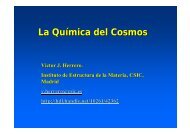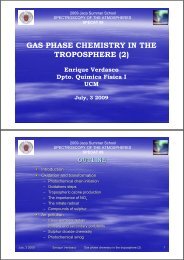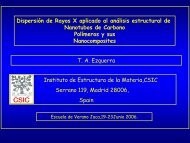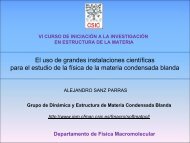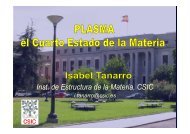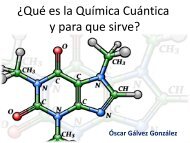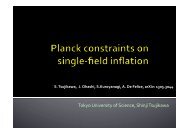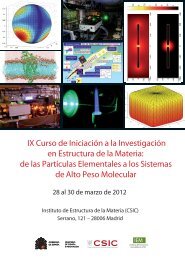product. The c<strong>la</strong>y can be used directly, without any previous chemical modification. One interesting aspect of thismethod is that some polymeric chains became directly grafted on the c<strong>la</strong>y p<strong>la</strong>telets, thus giving rise, for somecomposition,s to a complete c<strong>la</strong>y exfoliation. The same method has been applied to the preparation of binary orternary blends of the polymers above cited, that are normally consi<strong>de</strong>red as incompatible. The results obtained arevery promising.Dielectric properties of nanocomposites based on thermop<strong>la</strong>stic polymers reversibly crosslinked.Wishing totake advantage of our previous experience in this field, we have exten<strong>de</strong>d our investigation to some other polymersof increasing interest and wi<strong>de</strong> use, as, for instance, poly(ethylene terephtha<strong>la</strong>te) PET, poly(ethylene naphthalenedicarboxy<strong>la</strong>te) PEN, poly(methyl methacry<strong>la</strong>te) PMMA, and poly(vinyli<strong>de</strong>ne fluori<strong>de</strong>) PVDF. Moreover, we areespecially interested in applying the procedure to obtain nanocomposites in one step to the preparation ofnanocomposites of the preceding polymers with c<strong>la</strong>y, graphite, and some other additives. We are making an especialemphasis in the study of the dielectrical properties of the resulting materials.Polymer/organometallic polymer nanocomposites.We have carried out a <strong>de</strong>ep study on the advanced properties ofpolymer/organometallic polymer nanocomposites. In particu<strong>la</strong>r [Fe(II) (4-octa<strong>de</strong>cyl-1,2,4-triazol)3(ClO4)2] inPolystyrene (PS). Our results confirm that, even in the presence of PS, the structural transition associated to achange in the magnectic susceptibility of the organometallic polymes occurs. This transition is associated to theconversión from <strong>la</strong>mel<strong>la</strong>r to hexagonal structure in the organometallic polymer.The work has been carried out incol<strong>la</strong>boration with doctors Daniel López and Rebeca Hernán<strong>de</strong>z from <strong>Instituto</strong> <strong>de</strong> Ciencia y Tecnología <strong>de</strong>Polímeros (ICTP-CSIC) and with Doctor Ana Roig, from <strong>Instituto</strong> <strong>de</strong> Ciencia <strong>de</strong> <strong>Materia</strong>les <strong>de</strong> Barcelona (ICMAB-CSIC).ATOMIC FORCE MICROSCOPY(AFM)During the <strong>la</strong>st year <strong>2011</strong>the AFM facility has been implemented with a system to measure forces allowing not onlyvisualization by also assessment of mechanical properties at scales of nanometer. The new capabilities will enable toinvestigate mechanical properties such as e<strong>la</strong>stic modulus, adhesion and <strong>de</strong>formation forces as well as to performnanoin<strong>de</strong>ntation experiments.BIOSAXCharacterization of biologically interesting colloids and lipoplexes. We have continued with research on thestructuration of mix liposomes formed by a cationic and a zwiterionic lipid in the presence of DNA. By Small AngleX ray scattering we have <strong>de</strong>termined the effect of the lipidic composition in the structure of such lipoplexe and theresults have been compared with the theoretical phase diagram with an excellent agreement. This work has beencarried out in col<strong>la</strong>boration with the group of Prof. E. Aicart from the Química Física I <strong>de</strong>partment from UniversidadComplutense <strong>de</strong> Madrid.Research on new compounds and their influence on the assembly of microtubules.By means of X ray andNeutron scattering it is possible to extract information on the conformation of biologically interesting systems, like,as an example, proteins in solution. In col<strong>la</strong>boration with the group of Dr. F. Díaz from the Centro <strong>de</strong>Investigaciones Biológicas (CIB-CSIC), we are carrying out SAXS experiments on the influence of new antitumoralcompounds based on taxanes on the tubulin assembly. The goal is to un<strong>de</strong>rstand the mechanism, at atomic andmolecu<strong>la</strong>r level, of the microtubule assembly in the presence of the mentioned compounds.Group of BIOPHYSICS OF MACROMOLECULAR SYSTEMSSIMULATION OF PHYSICAL PHENOMENA IN MACROMOLECULAR SYSTEMSMelt macromolecu<strong>la</strong>r dynamics of polyolefins.Full Monte Carlo (MC) and molecu<strong>la</strong>r dynamics (MD) atomisticcomputer simu<strong>la</strong>tions of the molecu<strong>la</strong>r dimensions and dynamial processes in entangled linear and short chainbranched polyethylene chains were <strong>de</strong>signed to establish the effect of the molecu<strong>la</strong>r architecture on the diffusion andviscoe<strong>la</strong>stic properties. This strategy allows one to evaluate the <strong>de</strong>nsity and the intermolecu<strong>la</strong>r local packing (chainsize) in the melt by mapping of MD simu<strong>la</strong>tions on the reptation mo<strong>de</strong>l of <strong>de</strong> Gennes and Doi-Edwards. The resultsobtained illustrate the <strong>de</strong>pen<strong>de</strong>nce of the chain dimensions, the entanglement features, and the characteristicre<strong>la</strong>xation time of the transition from Rouse-to-reptation regimes with the molecu<strong>la</strong>r architecture of polyethylene forshort chain branching content between 0 and 55 per 1000 carbon atoms. The results are in very good agreement withthe experiments in the literature, and more interestingly with those obtained in our group in molecu<strong>la</strong>r mo<strong>de</strong>ls ofbranched polyolefins, characterized by a very homogeneous molecu<strong>la</strong>r architecture.76
Coarse-grained (CG) potentials to study polymer crystallization. The formation of polymer nuclei is the result ofthe folding back and forth into stems of the chain perpendicu<strong>la</strong>r to the <strong>la</strong>mel<strong>la</strong>r surface. It is well accepted thatexperiments cannot track the evolution of the system from the motion of individual polymer chains in the time scalein which the or<strong>de</strong>r events may occur. In this line, computer simu<strong>la</strong>tions represent an alternative way to shed light onthe crystallization mechanisms of polymers. However, the study of polymer crystallization with atomistic computersimu<strong>la</strong>tions is a difficult task, since one needs huge computational resources. One way to construct mo<strong>de</strong>ls with lesscomputational effort is to average out the fast motions (an unimportant in the required time scale) removing some ofthe atomistic <strong>de</strong>grees of freedom. Thus, the hard atomistic potentials are rep<strong>la</strong>ced by mean-force potentials. Thesepotentials are <strong>de</strong>rivated from atomistic simu<strong>la</strong>tions of small systems by using the iterative inverse Boltzmannmethod. We have performed studies of the crystallization processes of PVA and PE with different <strong>de</strong>gree ofbranching. In general, the CG mo<strong>de</strong>ls reproduce the atomistic behaviors and, when possible, the simu<strong>la</strong>tionsreproduce the avai<strong>la</strong>ble experimental data, i.e. crystallization, <strong>de</strong>nsity and molecu<strong>la</strong>r size as a function of thebranches.Simu<strong>la</strong>tion of the isothermal crystallization of polyethylene in presence of nanotubes.The main objective of thiswork consisted in the study of the carbon nanotube effect on the isothermal crystallization of polyethylene at 300K.This was accomplished by molecu<strong>la</strong>r dynamics simu<strong>la</strong>tions of pure polyethylene and ethylene/1-hexene copolymersin presence of a carbon nanotube. The nanotube presence offers a contact surface suitable to nucleation and wherethe crystal growth of the polymer chain is favoured. However, the polymer chain branching limits the crystalliteformation even in presence of the carbon nanotube. In general, these nanostructured mo<strong>de</strong>ls showed higher or<strong>de</strong>rand crystallinity that can be reflected in an improvement on the mechanical properties of these materials.MOBILITY, ORDER AND NANOSTRUCTURE IN MACROMOLECULAR SYSTEMSThe study of the physical properties in the melt of molecu<strong>la</strong>r mo<strong>de</strong>ls of polyolefins, blends and nanocomposites hasallowed study the effects of the molecu<strong>la</strong>r architecture in emerging physical propeties. The specific properties areespecially interesting in the case of blends and nanocomposites, as emerging phenomena seem to be re<strong>la</strong>ted tospecific interactions betweent the components of the systems. In what the nanostructure and solid state propertiesconcerns, an exhaustive study of the semicrystalline molecu<strong>la</strong>r mo<strong>de</strong>ls, blends and naocomposites has beenperformed using differential scanning calorimetry, wi<strong>de</strong> angle X-ray scattering and dynamic-mechanical analysis.The results obtained allow getting a <strong>de</strong>eper un<strong>de</strong>rstanding about the complex nature of the phase structure of thesystems and on the re<strong>la</strong>tionship between nanostructure and macroscopic physical properties. Additionally, thecrystalization process in dilute solution has been studied by transmision electron microscopy in polyolefin molecu<strong>la</strong>rmo<strong>de</strong>ls. This study stablishes the strong effect of branching in crystal size and habit, in agreement with our atomisticcomputer simu<strong>la</strong>tions.SIMULATION OF BIOMACROMOLECULAR SYSTEMSSimu<strong>la</strong>tion of dipepti<strong>de</strong> amino acids in aqueous solution. Dipepti<strong>de</strong> amino acids are important molecules becausethey are suitable mo<strong>de</strong>ls for the protein “bricks”. The study of the predominant conformations of all possibledipepti<strong>de</strong>s is relevant to un<strong>de</strong>rstand the secondary structural elements of proteins. We have combined umbrel<strong>la</strong>sampling molecu<strong>la</strong>r dynamics simu<strong>la</strong>tions (USMD) and multiple Bennet acceptance ratio (MBAR) estimators tocalcu<strong>la</strong>te the intrinsic conformations for each of the 19 amino acids, except proline. Our results confirm thatdipepti<strong>de</strong> exten<strong>de</strong>d conformations (P II and β) are more popu<strong>la</strong>ted than the helical α conformations, that in somecases is opposed to the simu<strong>la</strong>tion results in the literature. This difference has been attributed to the combination ofUSMD/MBAR methodology with OPLS-AA force field. Moreover, our results show a better agreement withrecently published propensities obtained by IR and Raman spectroscopy on the same amino acid dipepti<strong>de</strong>s. Thehydrogen bonds between water and dipepti<strong>de</strong>s have been wi<strong>de</strong>ly discussed. We have found that exten<strong>de</strong>dconformations have <strong>la</strong>rgest probabilities to form H bonds with water than helical ones. In the case of a<strong>la</strong>nine, wehave performed high level ab-initio molecu<strong>la</strong>r dynamics simu<strong>la</strong>tions (Car-Parrinello) to study these nonbon<strong>de</strong>dinteractions between solvent and dipepti<strong>de</strong>. The high level calcu<strong>la</strong>tions are in good agreement with the results fromboth USMD/MBAR simu<strong>la</strong>tions and experiments. It is worth to point out that this scientific activity started througha publication with a high impact in the media (V. Cruz, J. Ramos and J. Martínez-Sa<strong>la</strong>zar, “Water-mediatedconformations of the a<strong>la</strong>nine dipepti<strong>de</strong> as revealed by distributed umbrel<strong>la</strong> sampling simu<strong>la</strong>tions, QuantumMechanics based-calcu<strong>la</strong>tions and experimental data”, The Journal of Physical Chemistry B 115, 4880-4886,<strong>2011</strong>).ERBB receptors.The aberrant overexpression of some members of the Epithelial Growth Factor Receptor (EGFRor ERBB) family is associated to a poor prognosis in several cancer types, in particu<strong>la</strong>r, breast cancer. ERBB2 andERBB3 are two ERBB family members that are used as biomarkers corre<strong>la</strong>ted with more aggressive tumours. Thesetransmembrane proteins are associated to cellu<strong>la</strong>r proliferation and growth and are consi<strong>de</strong>red important targets foranti-cancer therapies.In our research group, molecu<strong>la</strong>r dynamics simu<strong>la</strong>tions at an atomistic scale are being done77
- Page 3:
INTRODUCCIÓNEl Instituto de Estruc
- Page 10 and 11:
Dra. Maria Esperanza Cagiao Escohot
- Page 12 and 13:
TALLER ÓPTICOD. José Lasvignes Pa
- Page 14 and 15:
2A.1 DPTO. DEQUÍMICA YFÍSICA TEÓ
- Page 16:
empezar a caer. Este fenómeno se e
- Page 19 and 20:
Existen varias diferencias entre la
- Page 21 and 22:
Estudio de las propiedades estructu
- Page 23 and 24:
poblar los estados de interés en 1
- Page 25 and 26: Si bien la técnica TF está bien e
- Page 27 and 28: que no se produzca la ruptura de en
- Page 30 and 31: antitumoral emodina mediante el efe
- Page 32 and 33: Esta formulación ha sido desarroll
- Page 34 and 35: oooooCriogenia.Espectroscopía Rama
- Page 36 and 37: FLUIDODINÁMICA MOLECULAREl princip
- Page 38 and 39: También se ha concluido y publicad
- Page 40 and 41: o Análisis mecánico en tracción:
- Page 42 and 43: cuerpo (BCC), tiene lugar la formac
- Page 44 and 45: BIOSAXSCaracterización de coloides
- Page 46 and 47: Sin embargo, desde el punto de vist
- Page 48 and 49: 2B.1 THEORETICAL PHYSICS AND CHEMIS
- Page 50 and 51: terms and that b) stellar pulsation
- Page 52 and 53: We have investigated transport thro
- Page 54 and 55: een proposed as possible interstell
- Page 56 and 57: The figure shows a compilation of t
- Page 58 and 59: oppositely aligned spins. This pair
- Page 60 and 61: PHYSICAL BEHAVIOR AT NANO-SCALESPro
- Page 62 and 63: done in collaboration with research
- Page 64 and 65: Finally, we have also conducted a w
- Page 66 and 67: species have been obtained from tim
- Page 68 and 69: Rideal mechanism, with a preference
- Page 70 and 71: Liquid hydrogen filament (5 micron
- Page 72 and 73: Nanostructure of polymer thin films
- Page 74 and 75: morphological model for Natural Rub
- Page 78 and 79: with the extracellular ERBBs domain
- Page 80 and 81: 3.1 DPTO. DEQUÍMICA YFÍSICA TEÓR
- Page 82 and 83: Duration: January 2010-December 201
- Page 84 and 85: Objectives: This Project aims at ob
- Page 86 and 87: Funding Institution: Comunidad de M
- Page 89 and 90: CAPÍTULO 4COOPERACIÓN CIENTÍFICA
- Page 91 and 92: 4.1.3 DPTO. DE FÍSICA MOLECULAR /
- Page 93 and 94: o Complete Hybrid Quantization of a
- Page 95 and 96: R3B Collaboration Meeting, Darmstad
- Page 97 and 98: SERS Roundtable 2011, Poltersdorf (
- Page 99 and 100: International Conference on Process
- Page 101 and 102: 4.3. ESTANCIAS DE INVESTIGADORES EN
- Page 103 and 104: Dr. Francesca Vidotto.Université d
- Page 105 and 106: 4.4.3 DPTO. DE FÍSICA MOLECULAR /
- Page 107: Guillermo Ribeiro Jiménez. Subatom
- Page 110 and 111: 5.1 DOCENCIA / TEACHING5.1.1 DPTO.
- Page 112 and 113: 5.1.3 DPTO. DE FÍSICA MOLECULAR /
- Page 114 and 115: 5.2.3 DPTO. DE FÍSICA MOLECULAR /
- Page 116 and 117: Óscar Gálvezo Hielos y Plasmas de
- Page 118 and 119: Olof Tengblad- Deputy Technical Man
- Page 120 and 121: 5.5 ACTIVIDADES Y MATERIAL DE DIVUL
- Page 122 and 123: Plasma, el cuarto estado de la mate
- Page 124 and 125: 5.7 UNIDADES ASOCIADAS Y OTRAS ACTI
- Page 126 and 127:
oScientific collaboration on “Din
- Page 128 and 129:
6.1 PUBLICACIONES EN REVISTAS Y PRO
- Page 130 and 131:
Prescriptions in Loop Quantum Cosmo
- Page 132 and 133:
Richardson-Gaudin Models: The Hyper
- Page 134 and 135:
79. L. Guerrini, S. Sanchez-Cortes,
- Page 136 and 137:
Probing the Nature of Particle-Core
- Page 138 and 139:
PROCEEDINGS ISI /ISI PROCEEDINGS120
- Page 140 and 141:
Physical Review Letters 106, 245301
- Page 142 and 143:
Conducting Nanocomposites Based on
- Page 144 and 145:
3. O. S. Kirsebom, S. Hyldegaard, M
- Page 146 and 147:
6.4 TESIS DOCTORALES / Ph. D. THESE
- Page 149 and 150:
CAPÍTULO 7TABLAS Y DATOSCHAPTER 7T
- Page 151 and 152:
Spectrochimica Acta B 2 3.552Chemph
- Page 153 and 154:
7.4 PERSONAL POR DEPARTAMENTOS /PER
- Page 155 and 156:
ÍNDICEINDEX155
- Page 157 and 158:
4.1.2 Dpto. de Espectroscopía Nucl
- Page 159:
6.2.2 Dpto. de Espectroscopía Nucl




